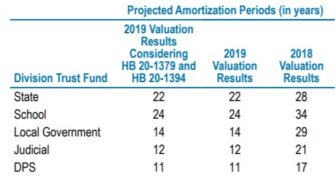As part of SB18-200, the Legislature created the Pension Review Subcommittee to be another set of eyes on PERA. While it has no authority over PERA, it does serve to review PERA’s progress and make recommendations to the PERA Board of Trustees and to the Legislature.
The Pension Review Subcommittee is under the Pension Review Commission, which was previously called the Police Officers’ and Firefighters’ Pension Reform Commission. SB18-200 expanded the scope of the commission from overseeing just the Fire and Police Pension Association (FPPA) to also overseeing PERA and established the subcommittee.
The subcommittee is comprised of four legislators, who also serve on the commission, and ten members with external expertise. These ten members are appointed as follows:
- The Governor appoints one member,
- The Treasurer appoints one member,
- The Senate President appoints two members,
- The Senate Minority Leader appoints two members,
- The Speaker of the House appoints two members, and
- The House Minority Leader appoints two members.
These members must have “experience or knowledge of investment management, corporate or public finance, compensation and benefit systems, economics, accounting, pension administration, or actuarial analysis.”
What is their charge?
The Pension Review Subcommittee is tasked with reviewing PERA’s overall financial health, their actuarial assumptions and progress to reaching full funding by 2048. They can make recommendations to the commission or PERA about their analysis and ways to improve the system.
The subcommittee began its work in 2019 and then paused in 2020 due to the pandemic when all interim committees were halted for the year. In 2021, the subcommittee is taking on the task of conducting an analysis of PERA’s efforts to reach full funding by 2048. It recently contracted with GRS, a national actuarial and benefits consulting firm, to do this analysis. Work on this project is just getting started.
In December of last year, PERA released its 2020 “Experience Study”. This study is done every four years and is used to set the actuarial assumptions, which are the underlying factors that affect PERA’s projections. The subcommittee’s review will include an analysis of this study, PERA’s overall assumptions and their projections.
You can learn more about the Pension Review Subcommittee on the Colorado Legislature’s website, including who serves on the Subcommittee now and their meeting information.


